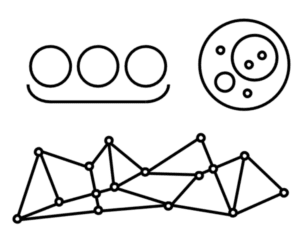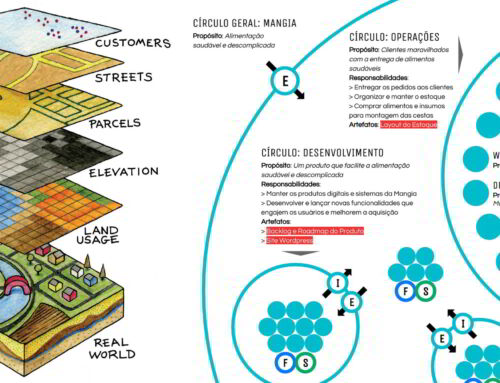In the book Reinventing Organizations, Frederic Laloux describes the five stages of organizational development, the latter being the “Evolutionary Teal”. The three great innovations introduced by this new organizational paradigm include evolutionary purpose, wholeness, and self-management.
However introducing self-management into an organization should not be reduced to empowering everyone or saying that people have autonomy. This can work when you have a team of up to 20 people. But what if you have 100 people? Or 9000 nurses, like at Buurtzorg? In this case you will need a bit more structure. ;)
During his research, Laloux discovered 3 different types of structure that allow scaling self-management for larger organizations. They are: Parallel Teams, Web of Individual Contracting and Nested Teams.
Self-Management Path #1: Parallel Teams (PT)
If the group of people needed to deliver end-to-end value in your organization is small, then the PT model is likely to be a good choice.
Buurtzorg, a Dutch home care organization, operates using autonomous teams of up to 12 nurses. They do all the work of value creation, including planning, scheduling visits, coordination, service delivery, and phone calls. There is no call center that centralizes calls! Oh, and the teams don’t have an assigned leader or manager.
During the training period of these teams, specialized coaches teach people how to work in a self-organized way. Nurses are trained in facilitation techniques, mediation, and conflict navigation. In addition to the more than 700 teams, there are 35 people who perform administrative and legal work (the backoffice). Otherwise, little coordination is needed between teams.
This self-management structure is often used in the service sector or in short-length value chain organizations. Using this structure it is possible to maintain several instances of value generation that act independently and in parallel.
Self-Management Path #2: Web of Individual Contracting (WIC)
The Web of Individual Contracting is a structure identified in Morning Star, an American tomato processor. Responsible for producing 40% of tomato sauce in the US, Morning Star has been operating with WIC for years.
The Morning Star process ranges from tomato growing to processing and distribution. The value chain is extremely long, requiring the work of hundreds of people to get the tomato sauce in the hands of the customer. In this scenario, the Parallel Teams structure certainly wouldn’t work.
Instead of defining a departmentalized, hierarchical structure, Morning Star employees establish “contracts” with each other that determine accountabilities, agreements, and production goals. This peer-to-peer process creates a reporting network that is not centralized in a person or in a chain of command. In addition to that, there are no managers or supervisors at Morning Star.
Another social technology normally present in organizations operating in WIC is the Advice Process. This process says that anyone in the organization can make any decision (including the purchase of a $ 100,000 machine) as long as it hears the “advice” of all people impacted or who have the knowledge to contribute. It’s not necessary to “integrate” all opinions, just listen to them.
Among the disadvantages of the WIC model is that it doesn’t provide a mechanism for structural changes. It’s usually best suited for organizations that don’t undergo many changes in the chain and in the production process.
Self-Management Path #3: Nested Teams (NT)
The most flexible and adaptable structure described by Laloux is the Nested Teams. Because of this attribute, it can be used in sectors where the value chain is long, complex and dynamic. The NT structure consists of circles that are subdivided into roles and other subcircles. There are binding roles that connect the layers and create an explicit communication channel between subcircle and supercircle.
Does it look like the hierarchical structure? Yes, there is a “hierarchy of circles”. But this hierarchy is a hierarchy of work scope (roles and circles), not jobs and people. In addition, there are several rules that prevent larger circles from interfering with the functioning of subcircles, ensuring self-management throughout the organization.
There are several social technologies that allow you to implement a Nested Team structure in your organization. Among the most popular are Classical Sociocracy, Holacracy and Sociocracy 3.0. If you want to know more about Holacracy, check this Beginner’s Guide that we have created.
Zappos, the American footwear giant, is one of the largest companies that adopted the NT structure so far.
These are the 3 different self-management structures presented by Frederic Laloux in his book Reinventing Organizations. Although they seem to be disruptive, a growing number of organizations have been applying these new social technologies in the world.
Don’t confuse self-management with lack of structure. Reflect about your organization needs and apply the right framework for your situation. Self-management is much more complex than saying that your organization is horizontal.






[…] Therefore autonomy to make decisions in the pursuit of the purpose of the organization needs to be stimulated. It’s not a careless and inconsistent autonomy. There are clear and explicit accountabilities. Decreasing hierarchy and distributing authority is possible. See here how. […]
[…] above are references. You may need to create something more custom for your context. That was what Buurtzorg, Morning Star and FAVI did. Just be careful though, because organizational development and design are complex matters. A more […]
[…] Three ways for self-management to work […]
[…] recognition. At Morning Star, there are no bosses or hierarchy, but a network of agreements that is formed among the workers. To change what you do (let’s call it a “promotion”), you simply rehire your work […]
[…] to blog readers: We use the word “agreement” a lot in the articles we talk about self-management and the social technology O2. Here we choose the word “promise”, as it is more closely related […]